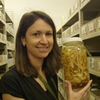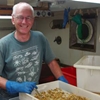General Description
Swollen carapace covering head and some of the thorax. The legs of the thorax are short and several help in feeding. Between a pair of lobes of the carapace are several minute eyes. The abdomen is a cylindrical sequence of segments ending in a fork-like tail. Telson fused to pleonite 6.
Biology
Cumaceans burrow into the surface of sandy and muddy sediments but can also be found in the sediment trapped among macroalgae. At night especially cumaceans can be active swimmers in the open water and this is probably where mating occurs. Food is obtained by filtering water just above the sediment and grazing on the surface of sand grains. Cumaceans can be dug out of sandy sediment but the most effective way of catching them is by attracting them to lights at night.
Habitat
Among macroalgae in sandy sediments, to depth of 23 m.
Soft substrates
Distribution guide
Southern temperate oceans, including western and southern Australia.
Species Group
Depth
Water Column
Max Size
8 mm
Diet
Organic matter
Commercial Species
No
Global Dispersal
Native to Australia
Species Code
MoV 78
Conservation Status
- DSE Advisory List : Not listed
- EPBC Act 1999 : Not listed
- IUCN Red List : Not listed










